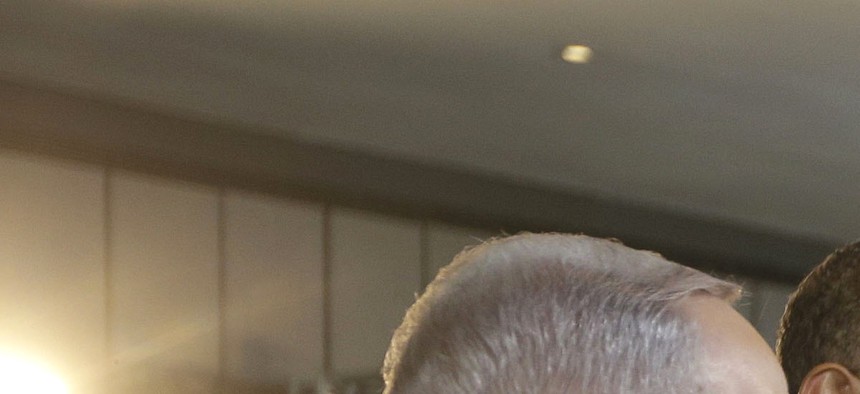
U.S. President Barack Obama, second left, and Israeli Prime Minister Benjamin Netanyahu, left, talk with Professor Amir Geva, right, wearing a device to monitor brain activity. Photo taken in Jerusalem, Israel,Thursday, March 13, 2013. AP / PABLO MARTINEZ
White House Project Will Yield Brain-Based Lie Detectors
How near-future advances in functional brain imaging will make enhanced interrogation an obsolete method of obtaining information.
President Obama’s 2016 budget request calls for $70 million in additional funding for the White House’s BRAIN Initiative – a large scale effort aimed at developing powerful new brain mapping technologies.
With support from agencies like the National Institutes of Health, NIH, and the Defense Advanced Research Projects Agency, DARPA, specific projects focused on drastically increasing the power of functional brain imaging tools are already underway. Improvements in this area will enable scientists to identify the neural correlates of cognitive processes - like those, for example, involved in deception – with far greater accuracy and precision.
Such advances could potentially eliminate the need for the interrogation tactics described in the so-called “CIA torture report," which created nationwide outrage upon its release last December.
The Senate Intelligence Committee’s report describes the brutal physical and mental abuse endured by Middle Eastern detainees suspected of terror from 2001 to 2006 – many of whom turned out to be completely innocent. To make matters worse, the document showed these unethical “enhanced interrogation techniques” to also be ineffective.
Equally troubling is the fact that even a superficial knowledge of neuroscience would suffice to know that extreme stress and sleep deprivation seriously impair memory and cognition. In fact, the whole concept of the enhanced interrogation approach is inherently flawed, as its techniques undeniably create a strong motivation to say anything that will cause the torture to cease, regardless of whether or not it is true.
(Related: How the Intelligence Community Can Move Beyond the Torture Report)
Still, it is imperative that we gather intelligence from captive terror suspects in order to prevent heinous crimes from taking innocent lives both at home and on the land of our allies abroad. But how exactly do we separate the good guys from the bad guys, and extract truthful information from the unwilling?
In a time where extremely hostile and advanced terrorist groups like the Islamic State (also known as ISIS or ISIL) are actively planning widespread civilian attacks on western nations, a reliable way of knowing whether a suspect is lying or not would provide an invaluable tool for protecting national security while preserving basic human rights.
One emerging technological solution to measure deception is functional Magnetic Resonance Imaging (fMRI), a non-invasive technique that allows researchers to track brain activity as a subject views stimuli or performs a task. FMRI works by measuring relative changes in blood oxygenation and flow within the brain. When certain parts of the brain increase activity, they ask for more oxygen-rich blood. FMRI uses a powerful magnetic field to detect which parts of the brain have more oxygen-rich blood in them at any one time. This is possible because oxygen-rich blood is slightly more magnetic than oxygen-deficient blood. Therefore, fMRI can show which parts of the brain “light up” when a subject thinks, speaks, or tells a lie.
Since its development in the 1990s, it has helped scientists much better understand what parts of the brain are associated with different functions.
While fMRI has shown great promise at spotting deception in laboratory settings, even reaching up to 90% accuracy in a 2005 study, there is essentially a consensus among scientists that these measures are at present too crude to be used for non-research purposes.
FMRI has, historically, been of limited use in deception detection due to its poor spatial resolution (a few millimeters), which limits the accuracy of the measure, making it difficult to determine the neural correlates of deception in sufficient detail.
But in the dawn of President Obama’s Brain Research through Advancing Innovative Neurotechnologies or BRAIN initiative – which is estimated to provide over $1 billion in funding over the next 10 years – we are guaranteed to see dramatic improvements in the resolution of neuroimaging in ways that could potentially be game changers for brain-based lie detection.
The BRAIN Initiative is neuroscience’s answer to the highly successful Human Genome Project, and its major goal is made obvious by its name. The initiative is aimed at building better brain mapping tools through multidisciplinary collaborations. If we want to chart the structure and function of the human brain in a comprehensive fashion, we have to see its activity close-up, and most desirably near the cellular level. Providing this degree of detail would no doubt significantly amplify the accuracy of lie detection functional imaging technology and greatly enhance its performance.
It just so happens that in September of last year, the BRAIN Initiative awarded $1.5 million to a team of researchers at UC Berkeley to develop a highly sensitive neuroimaging tool to replace fMRI. The new technology already has a name – functional Magnetic Particle Imaging (MPI) – and is described as having a resolution over 100 times higher than current fMRI technology. The leader of the effort, Stephen Conolly, has even built a working prototype. The project end date as specified on the NIH’s website is June 2017, so we can expect there to be a significantly more powerful brain imaging tool in use potentially sooner than just three years from now.
In the abstract of the official project description, which spells out exactly how the researchers plan to develop and test the MPI scanner, the authors write “We envision the sensitivity boon will have an instantaneous and revolutionary impact on neuroscience”. From the sound of it, the expectations couldn’t be much higher.
It appears that President Obama had not only anticipated such technology, but has also taken the measures necessary to address the more ethically challenging applications. Shortly after announcing the BRAIN Initiative in April of 2013, he called for the creation of the Bioethics Commission, the goal of which is to provide a set of core principles to guide those institutions developing neurotechnologies that are likely to give rise to deep moral and societal dilemmas.
In the commission’s initial report to the president, the first major example of a foreseeable application of concern was the use of neuroimaging tools for the purpose of detecting lies. The worry is that tools of this nature could inadvertently jeopardize the personal and mental privacy of those not guilty of any wrongdoing. These concerns are glaring signs that technologies capable of identifying deception in real world settings are rapidly emerging.
Not only is ultra-high resolution brain imaging technology coming soon, we can predict lie detection to be one of its earlier applications, considering its obvious usefulness to national defense agencies and academic researchers already studying fMRI-based lie detection – who are no doubt salivating at the thought of getting their paws on such tools.
MPI technology is unlikely to tell us anything about the specific contents of one’s mind anytime in the near future, which is a much harder feat (sorry conspiracy theorists, but mind-reading isn’t just around the corner). However, tools for spotting specific neural signatures of general cognitive processes, like those at work during deception, appear to be rapidly approaching head-on.
Unexpected and serious ethical consequences of this technology will no doubt arise, prompting fierce discussion and debate over the morality of these methods. However, as far as morality goes, I think it is safe to say that brain-based lie detection is a large step up from waterboarding. While capturing terror suspects and holding them for questioning will likely remain a necessity for a very long time, it is encouraging to know that technology capable of putting an end to “enhanced interrogation techniques” may not be far from reach.




